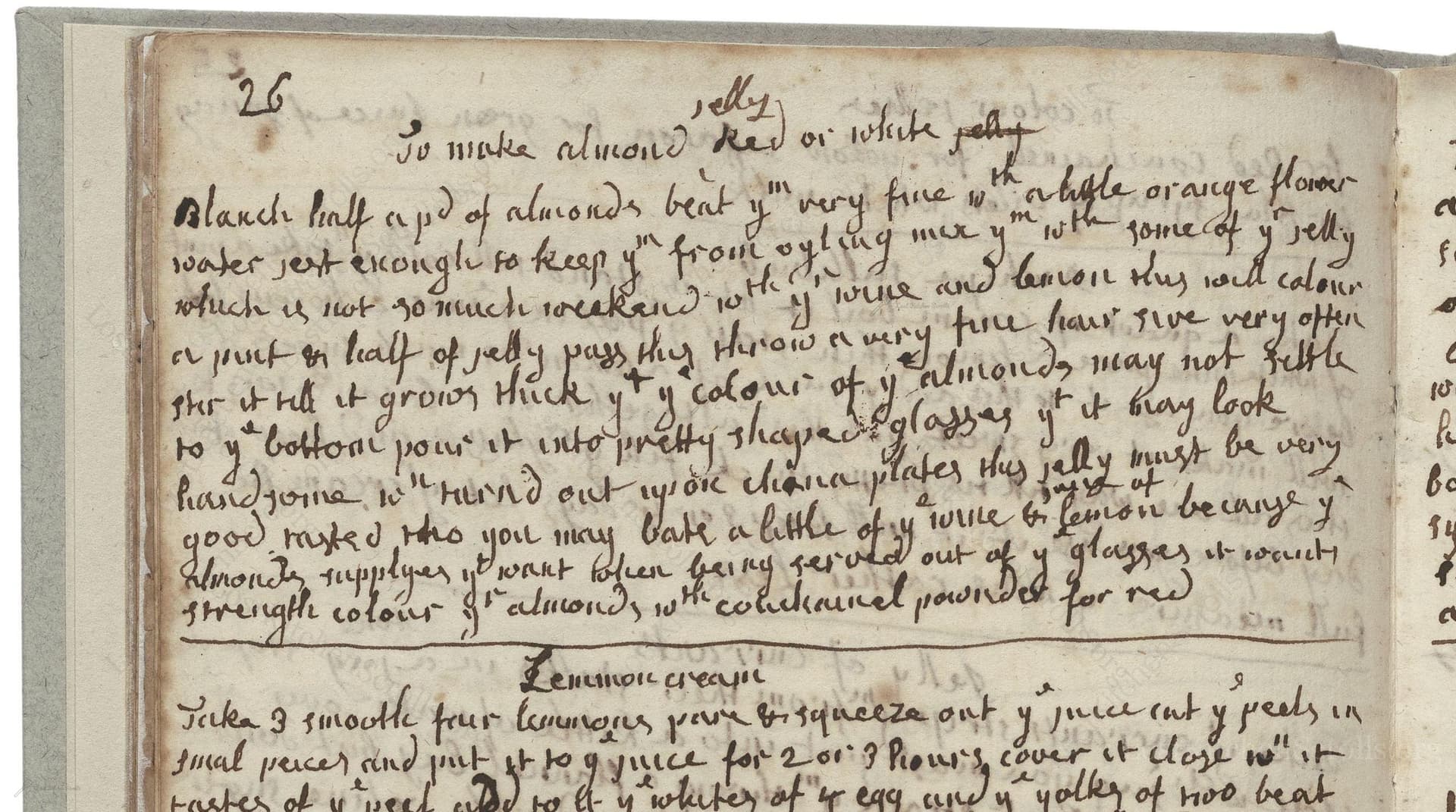To Make Almond Jelly Red Or White
From the treasured pages of Mrs. Knight's receipt book
Written by Mrs. Knight

To Make Almond Jelly Red Or White
"Blanch half a pd of almonds beat them very fine with a little orange flower water just enough to keep them from oyling mix them with some of the jelly which is not so much weakend with the wine a pint or half of jelly pass this throw a wire sive very often till it grows thick & the almonds may not settle to the bottom pour it into pretty shaped glasses if the jelly be very handsome. when turnd out upon china plates good tasted this you may bate a little of the Almonds, supplyes that want often being servd in strength colour of almonds with cochineel for red."
Note on the Original Text
18th-century recipes assumed a high degree of culinary experience and provided loose, narrative instructions rather than detailed measurements. Quantities such as 'half a pound' were approximated, and techniques were implied (e.g., 'pass through a wire sieve...till it grows thick'). Spelling and punctuation were idiosyncratic ('oyling' for oiling, 'sive' for sieve), and clarity was secondary to transmission of method, reflecting both manuscript culture and oral instruction. The recipe leaves sweetening and stiffening (with 'jelly') to the cook’s discretion, embracing the adaptable spirit of early modern cookery.

Title
Mrs. Knight's receipt book (1740)
You can also click the book image above to peruse the original tome
Writer
Mrs. Knight
Era
1740
Publisher
Unknown
Background
Step into the refined kitchens of 18th-century England with Mrs. Knight’s culinary collection, where time-honored recipes, hearty roasts, and elegant pastries await the enterprising cook.
Kindly made available by
Folger Shakespeare Library
This recipe hails from the mid-18th century, attributed to Mrs. Knight, circa 1740, at a time when elaborate jellies and almond desserts were fashionable, especially in British upper-class households. Almond jelly was a luxurious and artistic table centerpiece, showcasing both skill and access to imported ingredients like almonds, orange flower water, and cochineal for coloring. Recipes like this reflect both a penchant for elegant presentation and the influence of French culinary ideas on British cooking during the Georgian era.

Historically, almonds would be blanched in hot water and ground with a mortar and pestle or a stone metate. The orange flower water was added while grinding to prevent oiling. The jelly was made in a copper pan over the fire, strained through muslin or a fine sieve, and the almond mixture thoroughly passed — possibly multiple times — through a wire sieve to achieve that quintessentially smooth texture. Once prepared, the mixture was poured into decorative glass molds or shaped serving glasses, and sometimes unmolded onto porcelain plates for a grand presentation.
Prep Time
40 mins
Cook Time
0 mins
Servings
4
We've done our best to adapt this historical recipe for modern kitchens, but some details may still need refinement. We warmly welcome feedback from fellow cooks and culinary historians — your insights support the entire community!
Ingredients
- 8 ounces whole almonds
- 1–2 teaspoons orange flower water
- 2 cups clear jelly base (neutral gelatin or agar jelly, or unsweetened blancmange)
- Optional: sweet wine or sherry (if using for part of jelly base)
- Cochineal (or a few drops beetroot juice for red coloring)
- Sugar, to taste (if jelly base is unsweetened)
- Water (to prepare jelly base, if needed)
Instructions
- Begin by blanching 8 ounces of whole almonds to remove their skins, then grind them finely in a food processor or with a mortar and pestle, adding a splash (about 1–2 teaspoons) of orange flower water — just enough to keep the mixture from turning oily.
- Prepare about 2 cups of a clear jelly, such as gelatin-based aspic or a plain blancmange, but avoid over-diluting with wine or other liquids as clarity and firmness are desired.
- Mix the finely ground almonds into some of the jelly base (around 1–2 cups), ensuring the mixture thickens but remains pourable.
- Pass this liquid through a fine mesh sieve or strainer multiple times, aiming for a smooth, even texture where the ground almonds are suspended throughout and don't settle at the bottom.
- Pour the finished mixture into attractive glass molds or dessert glasses.
- If you wish to color the jelly red, add a few drops of natural cochineal (or a modern substitute like beet juice for color).
- Allow to set until firm, then unmold onto china plates to serve.
- Reduce the quantity of almonds for a subtler taste if desired.
Estimated Calories
170 per serving
Cooking Estimates
Blanching and grinding almonds takes about 20 minutes. Preparing and dissolving the jelly base typically takes 10 minutes, plus around 10 minutes to mix everything and strain for a smooth texture. Setting in the fridge takes about 3 hours, but you mostly wait during this time. Each serving has about 170 calories, mainly from almonds and sugar. The recipe makes 4 servings.
As noted above, we have made our best effort to translate and adapt this historical recipe for modern kitchens, taking into account ingredients nowadays, cooking techniques, measurements, and so on. However, historical recipes often contain assumptions that require interpretation.
We'd love for anyone to help improve these adaptations. Community contributions are highly welcome. If you have suggestions, corrections, or cooking tips based on your experience with this recipe, please share them below.
Join the Discussion
Rate This Recipe
Dietary Preference
Main Ingredients
Culinary Technique

Den Bockfisch In Einer Fleisch Suppen Zu Kochen
This recipe hails from a German manuscript cookbook compiled in 1696, a time whe...

Die Grieß Nudlen Zumachen
This recipe comes from a rather mysterious manuscript cookbook, penned anonymous...

Ein Boudain
This recipe comes from an anonymous German-language manuscript cookbook from 169...

Ein Gesaltzen Citroni
This recipe, dating from 1696, comes from an extensive anonymous German cookbook...
Browse our complete collection of time-honored recipes



